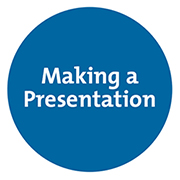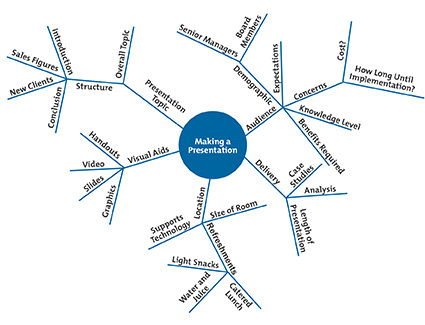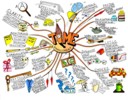Social Sciences
Source: http://www.mindtools.com/pages/article/newISS_01.htm
yourself with pages of information, but no clear view of how it fits
together?
This is where Mind Mapping can help you.
Mind Mapping is a useful technique that helps you learn more
effectively, improves the way that you record information, and supports
and enhances creative problem solving.
By using Mind Maps, you can quickly identify and understand the
structure of a subject. You can see the way that pieces of information
fit together, as well as recording the raw facts contained in normal
notes.
More than this, Mind Maps help you remember information, as they hold
it in a format that your mind finds easy to recall and quick to review.
use a two-dimensional structure, instead of the list format
conventionally used to take notes.
Mind Maps are more compact than conventional notes, often taking up
one side of paper. This helps you to make associations easily, and generate new ideas . If you find out more information after you have drawn a Mind Map, then you can easily integrate it with little disruption.
More than this, Mind Mapping helps you break large projects or topics
down into manageable chunks, so that you can plan effectively without
getting overwhelmed and without forgetting something important.
A good Mind Map shows the "shape" of the subject, the relative
importance of individual points, and the way in which facts relate to
one another. This means that they're very quick to review, as you can
often refresh information in your mind just by glancing at one. In this
way, they can be effective mnemonics ? remembering the shape and
structure of a Mind Map can give you the cues you need to remember the
information within it.
When created using colors and images or drawings, a Mind Map can even resemble a work of art!
1. Write the title of the subject you're exploring in the center of
the page, and draw a circle around it. This is shown by the circle
marked in figure 1, below.
(Our simple example shows someone brainstorming actions needed to deliver a successful presentation.)
 2. As you come across major subdivisions or subheadings of the topic
2. As you come across major subdivisions or subheadings of the topic
(or important facts that relate to the subject) draw lines out from this
circle. Label these lines with these subdivisions or subheadings. (See
figure 2, below.)
 3. As you "burrow" into the subject and uncover another level of
3. As you "burrow" into the subject and uncover another level of
information (further subheadings, or individual facts) belonging to the
subheadings, draw these as lines linked to the subheading lines. These
are shown in figure 3.
 4. Then, for individual facts or ideas, draw lines out from the
4. Then, for individual facts or ideas, draw lines out from the
appropriate heading line and label them. These are shown in Figure 4.
 5. As you come across new information, link it in to the Mind Map appropriately.
5. As you come across new information, link it in to the Mind Map appropriately.
A complete Mind Map may have main topic lines radiating in all
directions from the center. Sub-topics and facts will branch off these,
like branches and twigs from the trunk of a tree. You don't need to
worry about the structure you produce, as this will evolve of its own
accord.
develop your own conventions for taking them further. The following
suggestions can help you draw impactful Mind Maps:

only do Mind Maps show facts, they also show the overall structure of a
subject and the relative importance of individual parts of it. They help
you to associate ideas, think creatively, and make connections that you
might not otherwise make.
Mind Maps are useful for summarizing information, for consolidating
large chunks of information, for making connections, and for creative
problem solving.
To use Mind Maps effectively, make sure you print your words, use
different colors to add visual impact, and incorporate symbols and
images to further spur creative thinking.
If you do any form of research or note taking, try experimenting with Mind Maps. You'll love using them!
This site teaches you the skills you need for a happy and successful
career; and this is just one of many tools and resources that you'll
find here at Mind Tools. Subscribe to our free newsletter, or join the Mind Tools Club and really supercharge your career!
Add this article to My Learning Plan
Mind Maps®: Learning Skills from MindTools.com
- Structures, Diagrams, Rules, And Flows
When we refer to the structure of some complex entity, we often intend to capture one of the following ideas: the parts and their arrangementsthe parts and their interactionsthe flow of content -- information, money, value, ideas -- through a set of...
- More Geography Resources
Here are a few additional geography resources of note. In a previous post, I mentioned the National Geographic Xpeditions site, which is a great spot to find lessons and print-friendly maps. Another place to get maps, including "Maps with Historical Themes"...
- Holdings: Introduction To The Research Tools Mind Map
Introduction to the research tools mind map With the increasing use of information and communications technology (ICT), researchers are able to use computer software tools to find, organise, manipulate, analyse, and share relevant information....
- Information Visualization: Word Clouds, Phrase Nets, Tree Maps | Virtual Tool Cupboard | E-lab
Source: http://tools.elab.athabascau.ca/tutorials/information-visualization-word-clouds-phrase-nets-tree-maps Information Visualization: Word Clouds, Phrase Nets, Tree Maps Digital Creation: Information Visualization: Word Clouds, Phrase Nets,...
- Evolutionary Psychology
In June 2005 I had the opportunity to attend the Social Change Workshop for Graduate Students at the University of Virginia, a summer seminar organized by the Institute for Humane Studies (George Mason University). In that occasion, I could be introduced...
Social Sciences
Mind Maps®: Learning Skills from MindTools.com
Source: http://www.mindtools.com/pages/article/newISS_01.htm
Mind Maps®
A Powerful Approach to Note-Taking
(Also known as Mind Mapping, Concept Mapping, Spray Diagrams, and Spider Diagrams)
"Mind Map" is a trademark of the Buzan Organization (see www.buzan.com). We have no association with this organization.
Record ideas memorably
with James Manktelow & Amy Carlson.
Have you ever studied a subject or brainstormed an idea, only to findwith James Manktelow & Amy Carlson.
yourself with pages of information, but no clear view of how it fits
together?
This is where Mind Mapping can help you.
Mind Mapping is a useful technique that helps you learn more
effectively, improves the way that you record information, and supports
and enhances creative problem solving.
By using Mind Maps, you can quickly identify and understand the
structure of a subject. You can see the way that pieces of information
fit together, as well as recording the raw facts contained in normal
notes.
More than this, Mind Maps help you remember information, as they hold
it in a format that your mind finds easy to recall and quick to review.
About Mind Maps
Mind Maps were popularized by author and consultant, Tony Buzan. Theyuse a two-dimensional structure, instead of the list format
conventionally used to take notes.
Mind Maps are more compact than conventional notes, often taking up
one side of paper. This helps you to make associations easily, and generate new ideas . If you find out more information after you have drawn a Mind Map, then you can easily integrate it with little disruption.
More than this, Mind Mapping helps you break large projects or topics
down into manageable chunks, so that you can plan effectively without
getting overwhelmed and without forgetting something important.
A good Mind Map shows the "shape" of the subject, the relative
importance of individual points, and the way in which facts relate to
one another. This means that they're very quick to review, as you can
often refresh information in your mind just by glancing at one. In this
way, they can be effective mnemonics ? remembering the shape and
structure of a Mind Map can give you the cues you need to remember the
information within it.
When created using colors and images or drawings, a Mind Map can even resemble a work of art!
Uses
Mind Maps are useful for:- Brainstorming ? individually, and as a group.
- Summarizing information, and note taking.
- Consolidating information from different research sources.
- Thinking through complex problems.
- Presenting information in a format that shows the overall structure of your subject.
- Studying and memorizing information.
Drawing Basic Mind Maps
To draw a Mind Map, follow these steps:1. Write the title of the subject you're exploring in the center of
the page, and draw a circle around it. This is shown by the circle
marked in figure 1, below.
(Our simple example shows someone brainstorming actions needed to deliver a successful presentation.)
Figure 1

(or important facts that relate to the subject) draw lines out from this
circle. Label these lines with these subdivisions or subheadings. (See
figure 2, below.)
Figure 2

information (further subheadings, or individual facts) belonging to the
subheadings, draw these as lines linked to the subheading lines. These
are shown in figure 3.
Figure 3

appropriate heading line and label them. These are shown in Figure 4.
Figure 4

A complete Mind Map may have main topic lines radiating in all
directions from the center. Sub-topics and facts will branch off these,
like branches and twigs from the trunk of a tree. You don't need to
worry about the structure you produce, as this will evolve of its own
accord.
Tip:
While drawing Mind Maps by hand is appropriate in many cases, software tools and apps like Coggle, Bubbl.us, Mindmeister, MindGenius, iMindMap, and Mindjet can improve the process by helping you to produce high quality Mind Maps, which you can then easily edit or redraft. (Click here for a full list of Mind Map software.)Using Mind Maps Effectively
Once you understand how to take notes in Mind Map format, you candevelop your own conventions for taking them further. The following
suggestions can help you draw impactful Mind Maps:
Use Single Words or Simple Phrases ? Many words in
normal writing are padding, as they ensure that facts are conveyed in
the correct context, and in a format that is pleasant to read.
In Mind Maps, single strong words and short, meaningful phrases can
convey the same meaning more potently. Excess words just clutter the
Mind Map.- Print Words ? Joined up or indistinct writing is more difficult to read.
- Use Color to Separate Different Ideas ? This will
help you to separate ideas where necessary. It also helps you to
visualize the Mind Map for recall. Color can help to show the
organization of the subject. - Use Symbols and Images ? Pictures can help you to
remember information more effectively than words, so, where a symbol or
picture means something to you, use it. (You can use photo libraries
like iStockPhoto to source images inexpensively.) - Using Cross-Linkages ? Information in one part of a
Mind Map may relate to another part. Here you can draw lines to show
the cross-linkages. This helps you to see how one part of the subject
affects another.
Visual Example
Click on the thumbnail below for a great example of a Mind Map that has high visual impact:
Key Points
Mind Mapping is an extremely effective method of taking notes. Notonly do Mind Maps show facts, they also show the overall structure of a
subject and the relative importance of individual parts of it. They help
you to associate ideas, think creatively, and make connections that you
might not otherwise make.
Mind Maps are useful for summarizing information, for consolidating
large chunks of information, for making connections, and for creative
problem solving.
To use Mind Maps effectively, make sure you print your words, use
different colors to add visual impact, and incorporate symbols and
images to further spur creative thinking.
If you do any form of research or note taking, try experimenting with Mind Maps. You'll love using them!
career; and this is just one of many tools and resources that you'll
find here at Mind Tools. Subscribe to our free newsletter, or join the Mind Tools Club and really supercharge your career!
Add this article to My Learning Plan
Mind Maps®: Learning Skills from MindTools.com
- Structures, Diagrams, Rules, And Flows
When we refer to the structure of some complex entity, we often intend to capture one of the following ideas: the parts and their arrangementsthe parts and their interactionsthe flow of content -- information, money, value, ideas -- through a set of...
- More Geography Resources
Here are a few additional geography resources of note. In a previous post, I mentioned the National Geographic Xpeditions site, which is a great spot to find lessons and print-friendly maps. Another place to get maps, including "Maps with Historical Themes"...
- Holdings: Introduction To The Research Tools Mind Map
Introduction to the research tools mind map With the increasing use of information and communications technology (ICT), researchers are able to use computer software tools to find, organise, manipulate, analyse, and share relevant information....
- Information Visualization: Word Clouds, Phrase Nets, Tree Maps | Virtual Tool Cupboard | E-lab
Source: http://tools.elab.athabascau.ca/tutorials/information-visualization-word-clouds-phrase-nets-tree-maps Information Visualization: Word Clouds, Phrase Nets, Tree Maps Digital Creation: Information Visualization: Word Clouds, Phrase Nets,...
- Evolutionary Psychology
In June 2005 I had the opportunity to attend the Social Change Workshop for Graduate Students at the University of Virginia, a summer seminar organized by the Institute for Humane Studies (George Mason University). In that occasion, I could be introduced...

